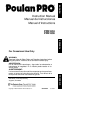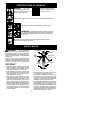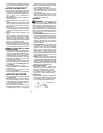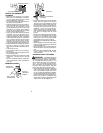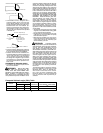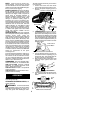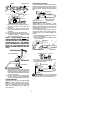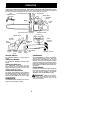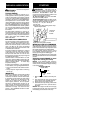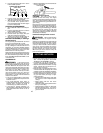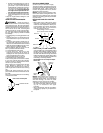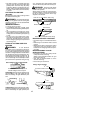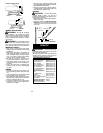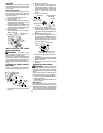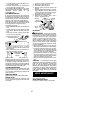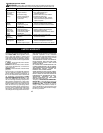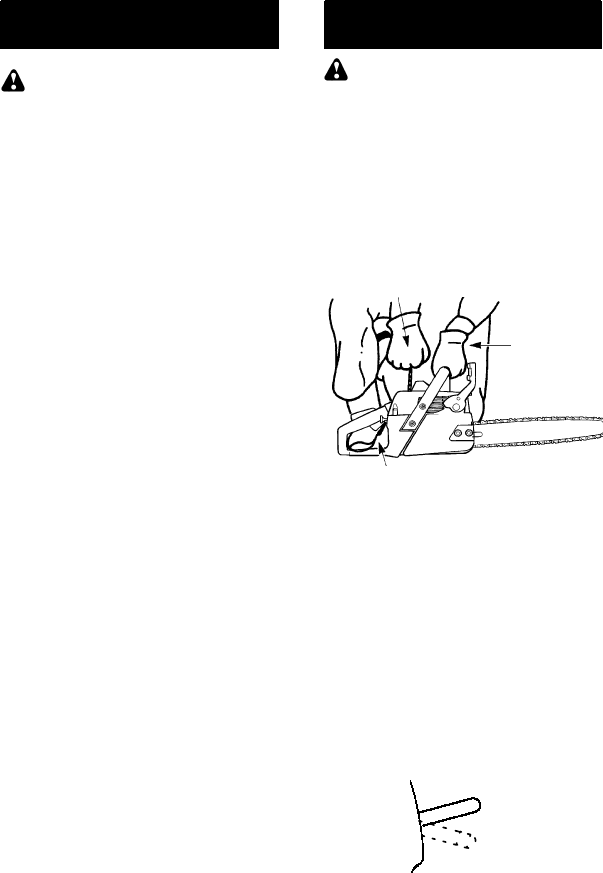
9
FUELING & LUBRICATION
W ARNING:
Removefuel capslow-
ly when refueling.
FUELING ENGINE
This engine is certified to operate on un-
leaded gasoline. Before operation, gasoline
must be mixed with a good quality synthetic
2-cycle air-cooled engine oil designed to be
mixed at a ratio of 40:1. Poulan/WeedEater
brand synthetic oil is recommended. A 40:1
ratiois obtainedbymixing 3.2ounces(95ml)
of o il wit h 1 gallon ( 4 lit ers) of unleaded gaso-
line. Include d with this saw is a 3.2ouncecon-
tainer of Poulan/Weed Eater brand synthetic
oil. Pour the entire conten ts of this container
in to 1 ga llon o f ga soline to achieve th e pr ope r
fuel mixture.
DO NOT USE automotive or marine oil.
Theseoils willcause enginedamage. When
mixing fuel follow the instructions printed on
the container. Always read and follow the
safety rules listed under HANDLE FUEL
WITH CAUTION.
BAR AND CHAIN LUBRICATION
The bar and chain require continuous lubri-
cation. Lubrication is provided by the auto-
matic oiler system when the oil tank is kept
filled. Lack of oil will quickly ruin the bar and
chain. Too little oil will cause overheating
shownby smokecomingfromthechainand/
or discoloration of the bar.
In freezingweatheroil will thicken, makingit
necessary to thin bar and chain oil with a
small amount (5to 10%) of#1 Diesel Fuel or
kerosene. Bar and chain oil must be free
flowing for theoil system to pump enoughoil
for adequate lubrication.
Genu ine Poula n or Poula n PR O
R
bar and
chain oil is recommended to protect your unit
aga inst excessive we ar from heat and friction.
Poulan or Poulan PRO
R
oil resists high
temperature thinning.
IfPoulanor PoulanPRO
R
barandchainoil
is notavailable,useagoodgradeSAE30oil.
S
Never u sewasteoil forbarandchainlubri-
cation.
S
Always stop the engine before removing
the oil cap.
IMPORTANT
Experience indicates that alcohol--blended
fuels (called gasohol or using ethanol or
methanol) can attract moisture which leads
to separation and formation of acids during
storage. Acidic gas can damage the fuel
system of an engine while in storage. To
avoid engine problems, the fuel system
should be emptied before storage for 30
days or longer . Drain the gas tank, start the
engine and let it run until the fuel lines and
carburetor are empty. Use fresh fuel next
season. See STORAGE section for addi-
tional information.
STARTING
WARNING:
The chain must not
move when the engine runs at idle speed. If
the chain moves at idle speed refer to CAR-
BURETOR ADJUSTMENT within this
manual. A void contactwith themuffler. Ahot
muffler can cause serious burns.
To stop the engine
move the ON/ST OP
switch to the STOP position.
T o start the engine
hold the saw firmly on the
gro und as illustrate d. M ake sur e the chain is
free to turn withou t conta cting any object.
Left Hand
on Front
Handle
Starter Rope Handle
Right Foot Through Rear Handle
Use only 15
!
-- 1 8
!
(38 -- 45 cm) of
rope per pull.
Hold saw firmly while pulling starter rope.
IMPORT ANT POINTS TO REMEMBER
Whenpullin gthest ar terr op e,dono tus ethefu ll
extent of th e ro pe a s this can cause the rop e to
break. Do not let starter rope sn ap back. Hold
the handle and let the rope rewind slowly .
For c old weather starting, start the unit at
FULL CHOKE; allow the engine to warm up
before squeezing the throttle trigger.
NOTE:
Do not attempt to cut material with
thechoke/fastidlelever intheFULLCHOKE
position.
STARTI NG A C OLD E NGI NE ( or warm
engine after running out of f uel )
NOTE:
In the following steps, when the
choke/fast idle lever is pulled out to the full
extent,the correct throttlesetting forstarting
is set automatically .
ON/STOP SWITCH
ON
STOP
(SIDE VIEW)
1. Move ON/ST OP switch to the ON p osi-
tion.
2. Pull choke/fast idle lever out to the full
extent (to the FULL CHOKE position).
3. Slowly press primer bulb 6 times.
4. Pull thestarter ropesharply 5 times with
your right hand. Then, proceed to the
next step.
NOTE:
If theengine soundsas if it is trying
to start before the 5th pull, stop pulling and
immediately proceed to the next step.



